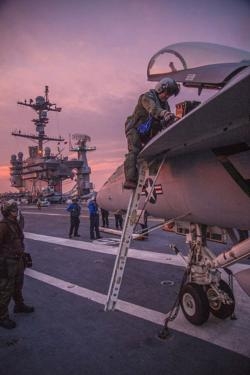Reaches 1,000 Traps While On Deployment Aboard USS George Washington
As the sun set over waters south of China, the commander of the U.S. Navy's forward-deployed air wing was on approach to Nimitz-class aircraft carrier USS George Washington (CVN 73) about to join a club of distinguished and experienced naval aviators who have achieved the career milestone of 1,000 arrested landings, or "traps."

Capt. William "Condor" Koyama, commander, Carrier Air Wing (CVW) 5, flying an F/A-18E Super Hornet from the "Dambusters" of Strike Fighter Squadron (VFA) 195, caught the number two arresting wire on George Washington's flight deck June 14 at approximately 6:48 p.m. (local).
"This is great honor and privilege," said Koyama "I was lucky in that I stayed in the cockpit for most of my career, and that is unusual today because of the other career development demands on aviators."
After making the successful landing, Koyama was joined by Sailors assigned to CVW-5's squadrons and George Washington in VFA-195's ready room to share celebratory cake and reflect on his accomplishment. He also took time to thank members of the arresting gear maintenance crew, without them those traps would not be possible.
"It was important to get the arresting gear folks in the ready room for cake," Koyama said. "If it were possible, though, I'd have had catapult crews, [aircraft launch and recovery equipment], reactor, etc., in there. The point is that without all of them I would have been able to fly exactly zero traps. I get the credit for sitting in the ejection seat, but each of them contributes to making the ship-air wing team function."
Koyama, a native of Oregon, received his naval aviator wings December 1990. He made his first trap aboard USS Lexington (CV 16). Since then, he has served aboard several other aircraft carriers. He was also previously assigned to CVW-5 in 2000 as a department head for the "Golden Dragons" of VFA-192 embarked aboard USS Kitty Hawk (CV 63) during Operation Enduring Freedom and Iraqi Freedom, as well as the CVW-5 deputy commander in 2011 before assuming command Dec. 13, 2013.

"There is no doubt in my mind that this is the best job in the world for a 'Tailhook' naval aviator," said Koyama. "After serving in tours based on the west coast, the east coast and Japan, when I screened for [air wing commander], I immediately requested to return to CVW-5. We are embarked more than any other air wing averaged over three years, and when we are ashore, I get to continue to work with and learn from all of our aircraft types, not just the strike fighters. Put another way, as [air wing commander] in Japan, you get your whole train set 24/7/365 of your entire three year tour, and you stay busy with them."
CVW-5 is a collection of aircraft designed to perform various functions and missions. The aircraft are attached to: the "Diamondbacks" of VFA-102 flying the F/A-18F Super Hornet; the "Royal Maces" of VFA-27, the "Eagles" of VFA-115 and VFA-195 each flying the F/A-18E Super Hornet; the "Shadowhawks" of Electronic Attack Squadron (VAQ) 141 flying the EA-18G Growler; the "Liberty Bells" of Airborne Early Warning Squadron (VAW) 115 flying the E-2C Hawkeye; the "Providers" of Fleet Logistics Support Squadron (VRC) 30, Detachment 5, flying the C-2A Greyhound; the "Golden Falcons" of Helicopter Sea Combat Squadron 12 flying the MH-60S Seahawk; and the "Saberhawks" of Helicopter Maritime Strike Squadron 77 flying the MH-60R Seahawk.
George Washington and CVW-5 are forward-deployed to the U.S. 7th Fleet area of operations to provide a combat-ready force that protects and defends the collective maritime interest of the U.S. and its allies and partners in the Indo-Asia-Pacific region.
ANN Salutes Mass Communication Specialist 1st Class Trevor Welsh, Commander, Task Force 70 Public Affairs
(U.S. Navy images)
 ANN's Daily Aero-Term (04.24.24): Runway Lead-in Light System
ANN's Daily Aero-Term (04.24.24): Runway Lead-in Light System ANN's Daily Aero-Linx (04.24.24)
ANN's Daily Aero-Linx (04.24.24) Aero-FAQ: Dave Juwel's Aviation Marketing Stories -- ITBOA BNITBOB
Aero-FAQ: Dave Juwel's Aviation Marketing Stories -- ITBOA BNITBOB Classic Aero-TV: Best Seat in The House -- 'Inside' The AeroShell Aerobatic Team
Classic Aero-TV: Best Seat in The House -- 'Inside' The AeroShell Aerobatic Team Airborne Affordable Flyers 04.18.24: CarbonCub UL, Fisher, Affordable Flyer Expo
Airborne Affordable Flyers 04.18.24: CarbonCub UL, Fisher, Affordable Flyer Expo




